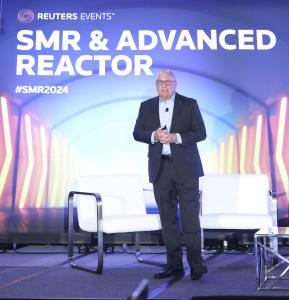
Small Modular Reactors Powering the No-Carbon Future
Small Modular Reactors will play a key role in the no-carbon electrical future.
CANTON, OHIO, USA, June 26, 2024 /EINPresswire.com/ -- As the United States moves toward a low/no-carbon economy, solar, wind and renewable natural gas (RNG) garner much of the media attention concerning power generation.
But another form of powergen has been producing commercial electricity since 1958 and is currently generating 20% of all power in the country.
Nuclear power is silent emission-free energy generation.
New commercial reactors for years have rarely been brought online, but manufacturers never stopped refining and designing their products.
Nuclear power production today is safer and much less risky than the behemoths built during its heyday in the 1970s and 80s.
Small Modular Reactors, or SMRs, are the hope of the nuclear industry. SMRs are reactors with a capacity of up to 300 MW per unit, one-third the power standard nuclear reactors can produce.
The smaller reactors can be assembled in a factory and are easier to transport than their traditional counterparts due to their smaller size.
The importance of SMRs were highlighted in May at the SMR & Advanced Reactor 2024 conference, presented by Reuters Events, in Atlanta.
“With coal facilities being taken off-line, we need to consider nuclear in addition to other forms of carbon free electrical generation” according to Bryce Custer, President of Ohio River Corridor, LLC.
With SMR and AR (Advanced Reactor) business projected at $18.8 billion market valuation by 2030, more than 600 attendees representing utilities, financiers, reactor developers, technology companies and regulators attended the two-day program.
Custer, who was one of more than 60 presenters in Atlanta, said the conference attendees were extremely optimistic about the future of SMR’s as an additional form of power to meet the ever-increasing needs of the electrical grid.
In his presentation, Custer laid out a scenario in which old, shuttered coal power plant acreage could be suitable for SMR placement.
“A 2022 US Department of Energy report found that more than 300 existing and retired coal power plant sites are suitable for SMR,” Custer told his audience.
Such a repurposing would preserve and create jobs, drive economic growth, sharply reduce energy-related CO2 emissions, and save money by utilizing existing infrastructure (transmission and distribution lines.)
“States considering a coal to nuclear transition include Arizona, Colorado, Kentucky, Maryland, Montana, North Carolina, Pennsylvania, Utah, West Virginia, and Wisconsin,” according to Custer.
Determining factors concerning repurposing coal plant acreage to SMR or Advanced Nuclear facilities, Custer said, include: securing community support; proper physical characteristics of the site; the ability to license through the Nuclear Regulatory Commission; access to existing infrastructure; and the needs of the power grid.
With the positives, there remain obstacles to conversion, including an aging infrastructure, site contamination, what to do with coal ash at the former coal site, along with varying amounts of heavy metals such as Arsenic, Mercury and Cadmium.
“There also is the problem of NIMBY, Not In My Backyard, thinking by many toward any nuclear power expansion anywhere,” Custer said.
SMR-based power units can be refueled every three to seven years instead of every one to two years for standard nuclear plants. Certain SMRs can operate without refueling for as long as three decades.
Small Modular Reactors also cost less to build and take less time to construct.
As well as being convenient to install and maintain, SMRs could positively impact the environment due to their zero carbon emissions.
An energy bill to expand nuclear power in the US cleared the Senate just this week by a wide bipartisan majority, and is expected to be signed by President Biden.
The so-called Advance Act (Accelerating Deployment of Versatile, Advanced Nuclear for Clean Energy) passed the House last month will incentivize creating and deploying new nuclear reactor technologies and reduce costs for companies who want to license such technologies.
“The US needs to embrace all low carbon energy options now and in the future.” According to Custer.
DOE earlier this month issued a Notice of Intent to fund up to $900 million to support the initial U.S. deployments of SMRs.
“The success of SMR’s will depend on universal, scalable technology and manufacturing to drive down costs and ease the permitting process.” said Custer.
Bryce Custer is the founder of Ohio River Corridor, LLC., a commercial real estate service company specializing in site selection, consultation and development along the Ohio River in Ohio, West Virginia, and Pennsylvania. Custer has over 30 years of experience in site selection, economic incentives, and corporate real estate both domestically and internationally. He has completed countless projects including data centers, distribution centers, headquarters, domestic and international manufacturing plants, retail, and information technology operations. Custer has written and been interviewed for a variety of business, site selection and real estate publications detailing his expertise in site selection, petrochemicals, plastics, and energy services.
Custer has in-depth knowledge of petrochemical, plastics, steel, and energy projects throughout the Ohio River area.
Custer has been involved with numerous site selection assignments for natural gas power plants and renewable energy projects. Custer is currently working on RNG, solar, hydropower, hydrogen, carbon capture & storage, and small modular reactor (SMR) projects requiring existing or readily attainable infrastructure that the Ohio River region provides. Custer has been tasked to locate project locations from 5-10 acres to over 2,000+ acres for companies, family offices and land bank investors.
Bryce A Custer
Ohio River Corridor, LLC
+1 3304189287
email us here
Visit us on social media:
LinkedIn
EIN Presswire does not exercise editorial control over third-party content provided, uploaded, published, or distributed by users of EIN Presswire. We are a distributor, not a publisher, of 3rd party content. Such content may contain the views, opinions, statements, offers, and other material of the respective users, suppliers, participants, or authors.


